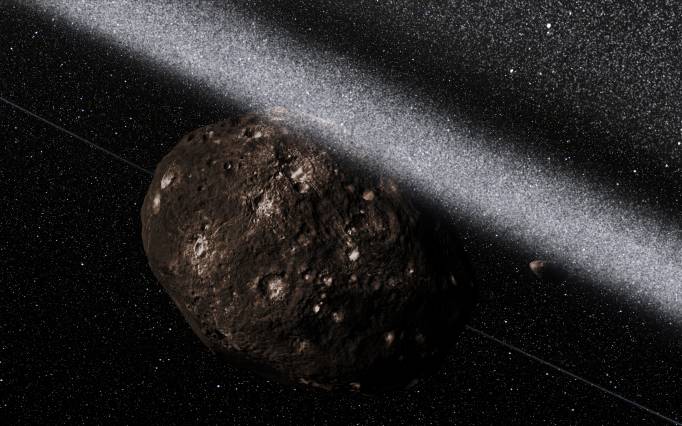
The new-found ringed planet. Image courtesy: European Southern Observatory/MIT
WASHINGTON (PTI): Scientists have detected a possible Saturn-like ring system around the minor planet Chiron, making it the sixth such object in our solar system.
There are only five bodies in our solar system that are known to bear rings. The most obvious is Saturn; to a lesser extent, rings of gas and dust also encircle Jupiter, Uranus and Neptune.
Scientists recently detected a ring system around Chariklo, one of a class of minor planets called centaurs.
Now scientists at Massachusetts Institute of Technology (MIT) and elsewhere have detected a possible ring system around a second centaur, Chiron.
In November 2011, the group observed a stellar occultation in which Chiron passed in front of a bright star, briefly blocking its light.
The researchers analysed the star's light emissions, and the momentary shadow created by Chiron, and identified optical features that suggest the centaur may possess a circulating disk of debris.
The team believes the features may signify a ring system, a circular shell of gas and dust, or symmetric jets of material shooting out from the centaur's surface.
"It's interesting, because Chiron is a centaur - part of that middle section of the solar system, between Jupiter and Pluto, where we originally weren't thinking things would be active, but it's turning out things are quite active," said Amanda Bosh, a lecturer in MIT's Department of Earth, Atmospheric and Planetary Sciences.
Chiron, discovered in 1977, was the first planetary body categorised as a centaur, after the mythological Greek creature - a hybrid of man and beast.
Like their mythological counterparts, centaurs are hybrids, embodying traits of both asteroids and comets.
Researchers obtained precise observations of Chiron, using two large telescopes in Hawaii.
They observed symmetrical, sharp features near the start and end of the stellar occultation - a sign that material such as dust might be blocking a fraction of the starlight.
The researchers observed two such features, each about 300 kilometres from the centre of the centaur.
In light of these new observations, the researchers said that Chiron may possess symmetrical jets of gas and dust.
However, other interpretations may be equally valid, including the "intriguing possibility," Bosh said, of a shell or ring of gas and dust.
Researchers said it is possible to imagine a scenario in which centaurs may form rings: For example, when a body breaks up, the resulting debris can be captured gravitationally around another body, such as Chiron. Rings can also be leftover material from the formation of Chiron itself.
An independent group has since combined the MIT group's occultation data with other light data, and has concluded that the features around Chiron most likely represent a ring system.
The research has been published in the journal Icarus.
 Previous Article
Previous Article Next Article
Next Article












The Indian Air Force, in its flight trials evaluation report submitted before the Defence Ministry l..
view articleAn insight into the Medium Multi-Role Combat Aircraft competition...
view articleSky enthusiasts can now spot the International Space Station (ISS) commanded by Indian-American astr..
view article